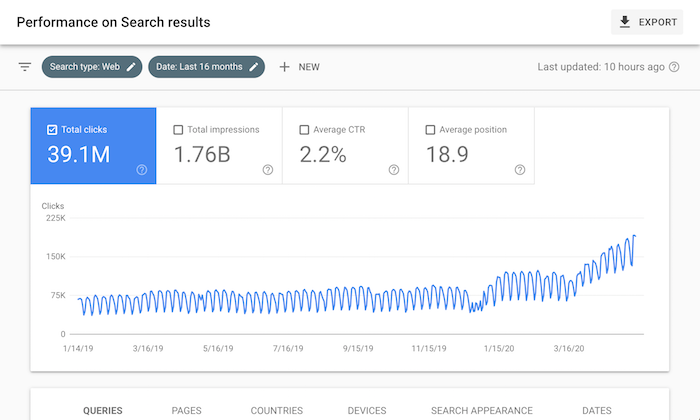
As you can see from the screenshot above, I’ve driven 30 million visitors to my website from SEO.
Technically it’s more, but who’s counting.
What’s funny, though, is I barely look at my traffic, even as Google continually rolls out algorithm updates.
I know that sounds contradictory because if you are an SEO, why wouldn’t you obsess about traffic, right?
Well, it’s because I’ve learned some hard lessons over the year… mainly because I’ve made a lot of mistakes.
So today, I wanted to share them with you so that you can learn from my mistakes… so here goes:
Lesson #1: Don’t obsess over rankings, obsess over conversions
I used to check my rankings every single day. Literally.
On top of that, I would log into Google Analytics 4 to 5 times a day and continually check my traffic.
That’s all I cared about back in the day… boosting my organic traffic.
But here is the thing: As my rankings and traffic went up over the years, my revenue didn’t go up proportionally.
For example, during one quarter in 2017, my SEO traffic went up 39.52%, but my revenue from SEO went up only 4.29%.
I quickly learned that traffic isn’t everything. If you can’t convert the traffic into revenue it doesn’t matter.
That taught me that you need to focus on the right keywords that drive conversions and continually optimize your site for conversions.
An easy first step for you to take is to install Crazy Egg and run a heatmap to see where people click so you adjust your design and copy to get more sales.

Lesson #2: The easiest way to grow your SEO traffic is international expansion
You already know that I get a lot of SEO traffic, but do you know what country drives most of my traffic?
If you guessed United States, you are wrong.
Brazil is my most popular region, followed by India.

International SEO is the easiest way to expand and grow your traffic. Here are a few posts that you should read before you expand your SEO globally:
- How to create a global SEO strategy
- Fundamentals of international SEO
- How to correctly setup your site for international SEO
- How to profitably expand your SEO globally
Lesson #3: Keywords are very, very, very, very important
When I used to write my content, I didn’t obsess about the keywords when I should have.
My team actually proved me wrong on this.
I used to focus on writing content for humans and didn’t worry about search engines. My team, on the other hand, obsesses about keywords.
Just look at the growth of our traffic in Brazil because of our obsession with the right keywords.

One simple thing I do before writing that has really helped is I head over to Ubersuggest and type in a few of the keywords that I want to go after.

Once it loads, you’ll see a report like the one above. I want you to then click on “Keyword Ideas” in the left-hand navigation.

You’ll see a report that contains a list of keywords that you could potentially be targeting.
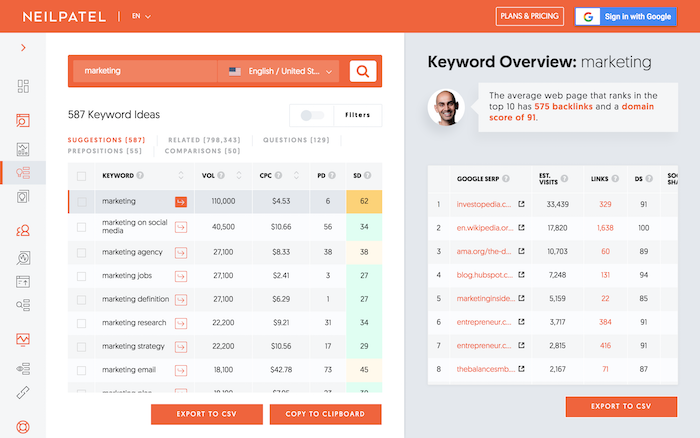
Make sure you click on the “Related” tab, as well as “Questions” and “Comparisons” … scroll through the list. You’ll see hundreds of keywords. Pick all of the ones that are relevant and ideally have a high cost per click (CPC). These are the keywords that’ll not only drive traffic but revenue as well.
Whenever I write a blog post, I go through this step. Every single time.
Lesson #4: AMP pages can drive more SEO traffic
AMP pages load faster on mobile devices than non-AMP pages.
If you aren’t familiar with the AMP framework, read this.
What most people won’t tell you about AMP pages is that:
- In regions like the United States, Canada, and the United Kingdom, countries with decent Internet infrastructure, you won’t see much of an increase in traffic.
- In regions with poor Internet infrastructure, like Brazil, you’ll see a 10 to 15% lift in mobile SEO traffic by having AMP pages.
- AMP pages don’t convert visitors into customers as well as normal responsive web design. So, you’ll have to work on testing your AMP pages so you can boost your conversion rates.
Lesson #5: SEO will never convert as well as paid ads
When I started off with SEO, I would run projections on how much the traffic would make me.
But the numbers were always off, even if I was able to get the rankings.
Here’s the main reason: If you are bidding on terms like auto insurance through ads, you can drive people to a landing page that looks like this:

But if you want to rank organically, you’ll have to do it through content. So, your page that ranks well will look more like this and convert less…

It doesn’t mean SEO is bad. In reality, it’s much cheaper in the long run than paid ads and will produce a better ROI. But don’t just assume that if you get 100 visitors from paid ads and 3 purchases that you’ll have the same conversion rate with your SEO traffic.
Chances are it will be significantly lower by maybe 2 or 3x, but because SEO is cheaper, it will be much more profitable.
Lesson #6: Remarketing is one of the best ways to generate an ROI from SEO
If you get a ton of traffic from SEO, there is a simple strategy you can implement to boost your conversions.
Remarket everyone on Facebook, Google, and YouTube.
That way people come to your site, read your content, and build trust with you and your brand.
Then you remarket them throughout the web with ads that prompt your products or services and send them to a landing page that will drive sales.
I’ve been doing this for years, just look at my old remarketing ad…
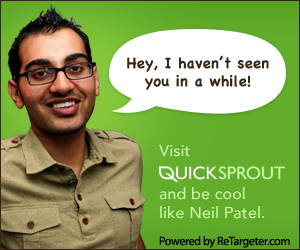
For the regions I use remarketing in, it is responsible for 46% of my leads.
Lesson #7: Don’t forget to update your old content
I publish one new blog post a week. I’m working on increasing this as I get more time, but for now, it is one a week.
Can you guess how many blog posts I update on a daily basis? Technically it is 0 (me at least), but my team focuses on updating at least 3 old blog posts per day. That’s roughly 90 a month.
Once you have a few hundred pages, make sure you focus on updating your old content or else your traffic will quickly drop.
You can use this content decay tool to see which posts you should update first.
This will help you continually grow your SEO traffic instead of hitting plateaus or seeing your traffic take massive drops.
Lesson #8: Don’t forget to optimize your title tags
One of the easiest ways to grow your rankings is to optimize your title tags.
If you can write persuasive copy and get more clicks, you’ll quickly move up on Google.
In Brazil, we spend more time doing this than we do in the United States.
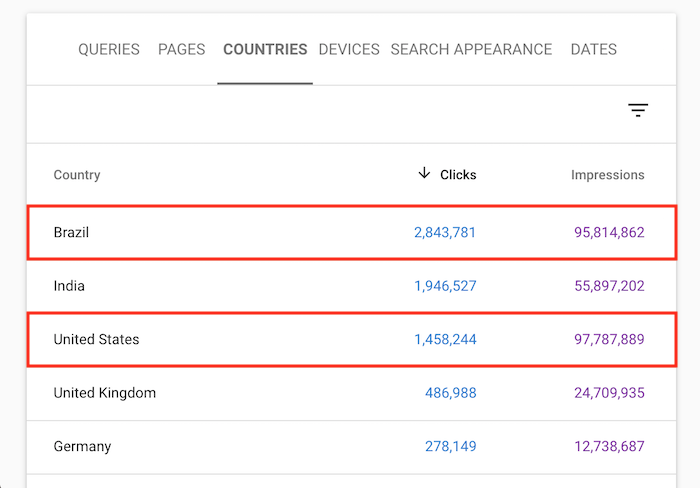
We get a similar amount of impressions in Brazil, but we have more people focusing on improving our title tags and testing. Hence, we get 95% more SEO traffic in Brazil.
If you want tips on boosting your clicks, check out this article.
Another simple hack is to use the “Content Ideas” report in Ubersuggest.
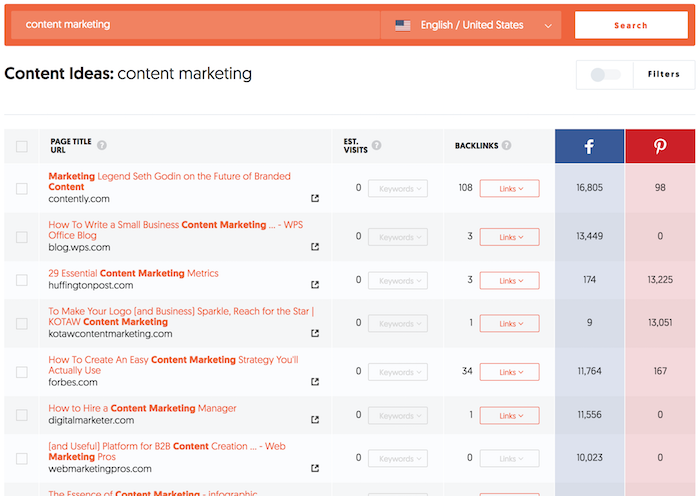
On the right side of that report, you can see social share counts from Facebook and Pinterest. And on the left side, you see titles of articles.
Typically, if people like a title they share it more. So, look for titles that have a lot of shares as it will give you ideas on what you can use on your website to get more clicks and boost your rankings.
Lesson #9: Don’t put dates in your URL
I used to put dates in my URLs like:
Neilpatel.com/2017/12/title-of-post/
This causes search engines to assume that your content is related to a specific date. And after that date gets old, search engines assume your content is irrelevant and outdated.
The moment I removed the date from my URLs, I grew my SEO traffic by 58% in 30 days.
If you have dates in your URL, make sure you 301 redirect your old URLs to your new ones once you make that change, or else your rankings will drop.
Lesson #10: Don’t be afraid to use popups
Don’t you hate popups? Well, who doesn’t?
But people use them because they work.
The majority of your pages that will rank are blog-related content. And blog posts tend to drive fewer direct conversions because people are on your site to read the content.
In order to maximize your conversions from SEO, you should consider using exit popups so you can convert more of those visitors into customers as they leave.
When you leave this site in most cases, you’ll see a popup that looks like:

And it drives you to this quiz, which allows me to convert SEO visitors into customers.
You can easily copy me by using Hello Bar. It works for all industries including B2B and ecommerce and even lead generation sites.
Lesson #11: Brand queries affect rankings
Everyone talks about how you need links to boost rankings.
But very few people talk about brand queries.
As Google’s ex-CEO and ex-head of web spam both emphasized how brands are important.

One of the big reasons for my growth in SEO traffic is the growth in my brand. I’ve seen a direct correlation in which the more people who find me from my name, the more SEO traffic I get.
Just look at my brand growth over time:
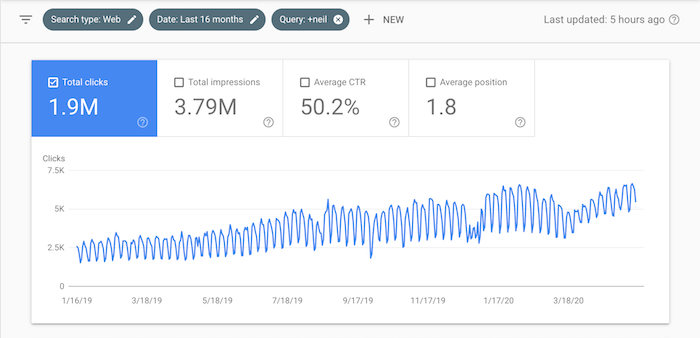
I’ve received over 1.9 million visitors over the last 16 months from people typing in variations of my name in Google.
Lesson #12: Don’t waste your money on paid links
I’ve been doing SEO since I was 16 years old. That’s a long time…
When I started off as a kid, I dabbled in paid links and I used to dominate Google for terms like online casino, online poker, web hosting, auto insurance, and even credit cards.
And I was making a killing off of affiliate income from these sites.
But it was all short lived.
Why?
Because I bought links. And eventually Google penalized all of those sites.
If I never purchased links, those sites would have taken longer to rank, but they would have been around today, and I would have generated more income overall.
Don’t buy links, it’s bad and shortsighted.
Lesson #13: Guest post to build a brand, not to build links
I already covered the importance of branding above.
A great way to build your brand and indirectly boost your SEO traffic is through guest posting.
But don’t use guest posting to build links.
Most sites that offer guest posts, nofollow them (which they should), and Google is smart enough to know what a guest post is, hence they ignore guest post links from sites like Forbes.
It’s pretty easy to spot a guest post for both a human and algorithm…

But if you are using it to build a brand, great. Focus on the content quality and not links.
Lesson #14: Don’t forget to interlink
Do you know what some of my highest ranked pages are?
The ones that are interlinked.
It takes anywhere from 6 months to a year for many of the interlinks to kick in, but it is still effective none-the-less.
Every time I wrote content, I used to make sure I link out to my older pieces of content when it made sense. But I made a big mistake… I wasn’t going into my older pieces of content and then adding links to my newer pieces of content.
That one change was game-changing for me. It took time to see the results but it worked exceptionally well.
It’s how I rank high for terms like “email marketing”.
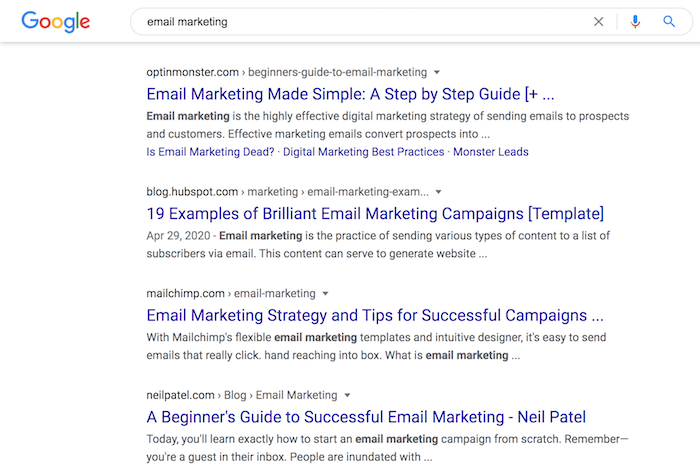
Lesson #15: Google isn’t the only game in town
Although Google is the most popular search engine, it isn’t the only one you need to focus on.
Did you know that YouTube is the second most popular search engine?
Even Bing gets a lot of traffic.
If you want to rank high on Bing, follow this.
Or if you prefer video, watch this:
As for YouTube, this guide will teach you YouTube SEO. It works really well, just look at my YouTube SEO traffic:
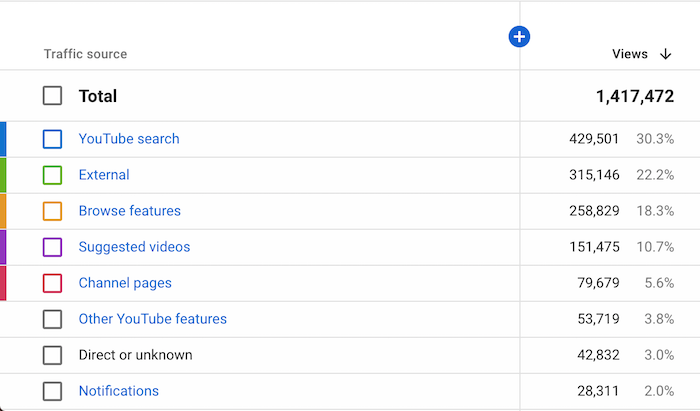
Over the last 28 days, I received 429,501 video views through YouTube SEO.
Lesson #16: Speed is everything
The faster your server and the more optimized your site, the more traffic you’ll get.
Years ago, my friend Otis added more servers to his site GoodReads.
Within a month, his SEO traffic went up over 20%.
Speed is part of Google’s algorithm, so optimize it for both web and mobile.
A quick way to see your site’s speed is to enter your URL here.
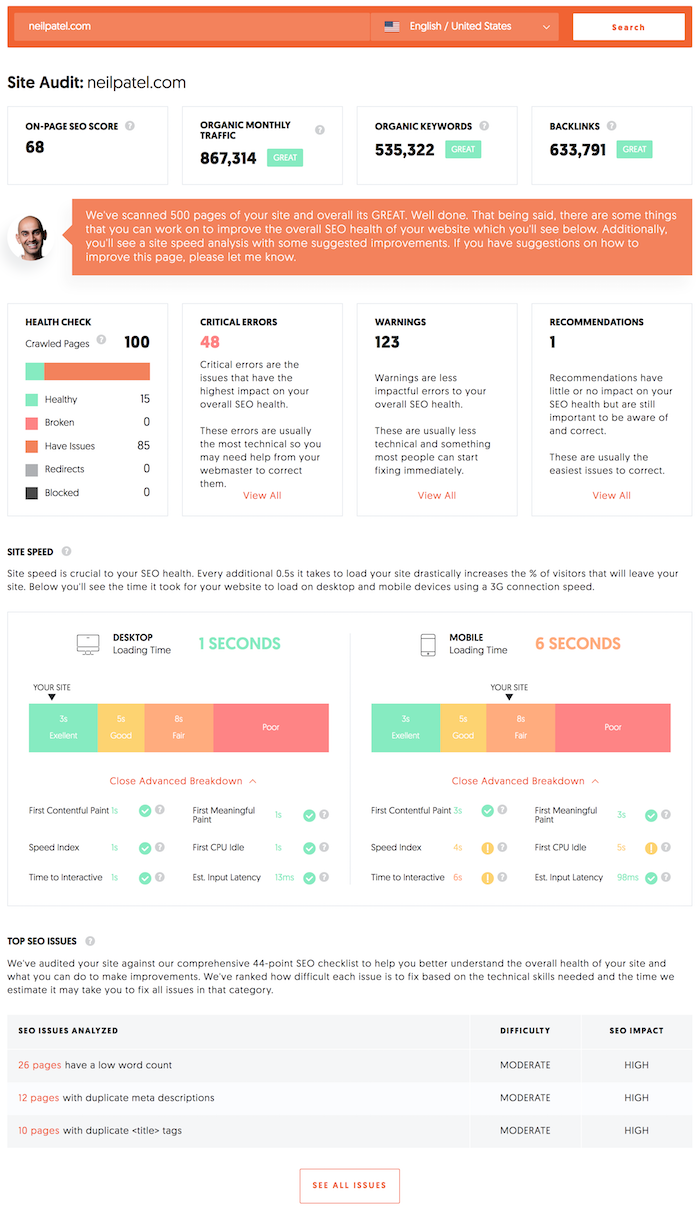
You’ll see a report that breaks down your mobile and desktop load times as well as what you can do to improve them.
Lesson #17: Quality over quantity
SEO used to be a game of quantity over quality.
That isn’t the case anymore. With over a billion blogs, Google has its fair share of sites to choose from.
Just look at About.com. Eventually they renamed it Dotdash and changed their strategy.
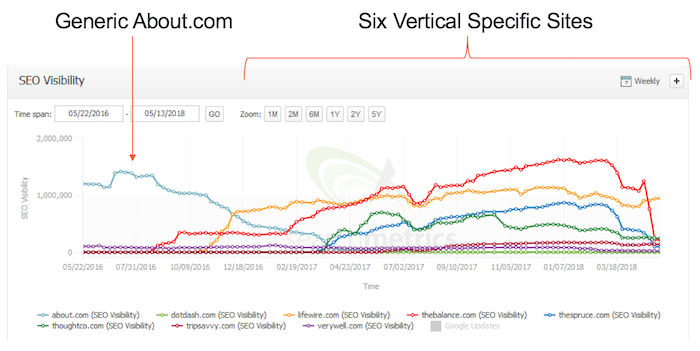
They took all of their About.com content and moved it over to 6 vertical based sites and deleted 900,000 pages of junk content.
This grew their traffic and revenue by a whopping 140%.
Focus on writing high-quality content. It’s why I blog less and try to make my content amazing.
Lesson #18: Tools are better than content marketing
I used to focus all of my energy on content marketing because it drove a lot of links and SEO traffic.
But over time, I realized that creating free tools builds more natural links than anything else I have ever tested.
Just look at Ubersuggest. I spent years creating it and look at how many links it has generated…

30,603 backlinks! That’s a lot of links.
If you don’t have the resources to build a custom tool like me, you can always start with buying a white label tool from Code Canyon for $10 or $20. They literally have tools for almost all industries.
Lesson #19: Don’t rely only on SEO
When I first got started in SEO, all I could think about was SEO.
To me, it was the best marketing channel out there because it allowed me to compete with large companies.
Even to this day, I still love SEO more than any other channel.
But it doesn’t stop me from leveraging other marketing channels.
See, years ago you could build a business off of one marketing channel.
Yelp was built through SEO. Dropbox through social media referrals. Facebook through email invites…
Those days don’t exist anymore. You can’t just build your traffic from one channel.
Although you should do SEO, you should also try paid ads, social media marketing, email marketing, push notifications, and anything else that comes out.
Diversify your traffic sources and don’t just rely solely on SEO.
Lesson #20: People love linking to data
Spending money and time to gather your own unique data is an easy way to build links.
Check out my posts on content marketing trends and social media trends.
I’ve added tons of unique data, stats, and charts to each of those pos
source https://neilpatel.com/blog/seo-visitors/
No comments:
Post a Comment